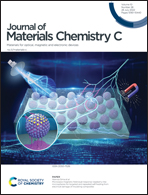Eu(iii)-Functionalized HOFs based on machine learning-assisted fluorescence sensing: discrimination of quinolones via PCA and BPNN models†
Abstract
Quinolones (QNs), as significant synthetic antibacterial agents, have been extensively applied to remedy digestive, urinary and respiratory infections in humans. With the evolution of sensing technology in the direction of intelligence, machine learning (ML) for analyzing and processing data can be widely leveraged for detecting chemical species. Herein, a Eu3+-functionalized hydrogen-bonded organic framework (Eu@HOF-GS-10, 1) has been manufactured via ion exchange between Eu3+ and guanidine cations, which emits obvious red fluorescence. Based on the principal component analysis (PCA) of ML, eight types of QNs have been precisely distinguished by analyzing the fluorescence response patterns of 1 mixed with the QNs. 1 as a sensor can respond rapidly to the eight QNs, varying from 26 s to 79 s, and be recycled four times. More importantly, further studies on the concentration fluorescence response of the specific QNs have been carried out via a back propagation neural network (BPNN), and measurement with high sensitivity and fast response can be realized to discriminate QN concentration by deep learning (DL).



 Please wait while we load your content...
Please wait while we load your content...